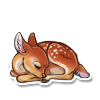Username;; discter
Kalon name;; Peach
Animal fact;; The
Stalk-eyed fly is gonna be my example. Males, when they first hatch and their exoskeleton is very soft, will swallow air into it's head. They will then push the air with their legs into the stalks of their eyes, elongating them as far as possible. Usually when they do this, they are typically in the sunlight, so after a while, the exoskeleton will harden thanks to both sunlight and natural hardening. That way, the air bubbles will be stuck in the stalks as the exoskeleton hardens.
Doubt me?

Extra facts (Ty Sixbane!!):
Giraffes use to roam parts of Asia and Europe, and are very much wanderers. The only thing stopping them is humans and water, due to Giraffes being terrible swimmers and poachers. Wanna know more? In order to help them survive against predators, they have developed a way to not get dizzy. That way when they pop their head up when they are drinking in order to search for predators, they don't get dizzy and fall over. They do make noise, but it's very low on the scale, so you can barely hear it, and they typically do it at night, or at least we can hear it better than.
Naked mole rats - This guy is the longest living rodent (up to 32 years), and lacks pain sensitivity in it's skin. It's also very resistant to cancer and oxygen deprivation, which helps since they live under ground. The naked mole-rat survives for at least 5 hours in air that contains only 5% oxygen; it does not show any significant signs of distress and continues normal activity. It can live in an atmosphere of 80% CO2 and 20% oxygen. (Thanks Wikipedia!) The litter can be anywhere from three to twenty-eight pups, and queens (dominant female - which is the only one that reproduces for the whole colony). Queens are also different from the other rats, they elongate their spine and widen their hips and pelvis in order to successfully have pups without serious internal damage.
Killer whale - Killer whales live in pods, and each pod has it's own unique cultural customs, such as hunting skills. Not entirely sure on this one, but I have heard that their brain is much more complex than humans, so they might have more emotions than us?? Not sure on that.
Crows/Ravens - These guys are so smart, they can recognize human faces, and will form opinions based on what humans and other animals do to them. They can also solve puzzles in order to get food.
Kangaroo - Kangaroo ancestors are actually from the trees, and a few species that live in the trees remain.
Wolverine - Wolverines can have a territory of up to 500 miles, and can go up to 30mph even with thick heavy snow and mountains thanks to their big paws. Each one also has a unique and special white patch on their chest, sorta like how snowflakes are. Males will have mates with multiple females and will help them raise their young, usually sticking around for a few months to a year.
Kiwi - Kiwi's have the largest body to egg ratio of any bird, so much so that kiwi eggs are SIX times bigger than a normal bird for the kiwi's size. Plus, they have developed their nostrils on the ends of their beak due to usually eating insects on the ground, and I believe they are the only birds to do so but now I'm not so sure so ??
Hummingbirds - Due to the fact that their heart beats so fast (1,260), they cannot enter a sleep like most other animals do. Instead, they go into a hibernation state like bears each and every night.
Parrot fish and clownfish - Can change their sex when the lead Male/mate dies. Oysters do that too, but that depends on which is best for the mating season.
Cats - Most, if not all cats have poor eyesight up close. In order to make their way around and 'see', their whiskers tell them what's going on, and is very useful for telling if prey is close enough to bite. They also have 32 muscles in each ear. Big cats, such as jaguars, have been known to attack and eat crocodiles/alligators.
Dragonflies (certain species) - The females will drop 'dead' in order to confuse males, so that way the males will leave them alone.
Cheetah's chirp - and prefer to stand on tall places, like rocks, in order to get a view of their surroundings better. They can also get really stressed, so zoos get them therapy dogs. They also used to live in north america, but went extinct.
Butterflies can only see the colors red, yellow, and green, even though they have thousands of lens on each eye.
Dogs - dogs are capable of recognizing sadness in humans, as well as facial expressions.
Owls - It's 180 degrees. 360 means their neck would snap off. You probably already know this, but this one bothers me when people say it's 360 for some reason. I don't even know why I'm salty about it??
Golden jellyfish eat sunlight - and I thought I heard about a species of jelly that isn't poisonous and I thought it was this one but now???
Frogs - Certain frog species (usually those that live in rain forests), will give birth to their young in the open, where the father will then transport them to a leaf that has water, food, air, and shelter for it.
Seahorses are so slow they only move about 0.01 mph.
The Sun Bear has the longest tongue of all bears, which is 8 - 10 inches long. They also bark.







.jpg)

.jpg)
.jpg)







